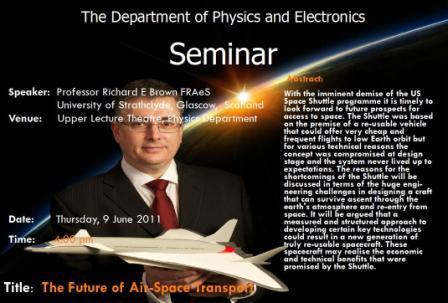
Space travel and the concept of conquering space has held a fascination for people across the ages. With the United States Space Shuttle Programme nearing its retirement; a discussion at Rhodes about the future of air space travel was particularly apt.
Used by NASA and the US Defence Force, the re-useable shuttle has seen more than one hundred launches. This has not been without severe technological and economic failures.
Professor Richard Brown addressed staff and students of Rhodes and Kingswood College on the reasons for the failure to ‘conquer space’ thus far and possible innovations in design and economic models necessary to do so in future.
Among the suggestions put forward for achieving economic efficient space travel was to get inspiration from the airline Industry. Brown stated that the re-usability of a space craft was seen as an affordable way of entering space but that is has been an “economic catastrophe” in terms of design. He said that the airline industry had virtually turned re-usability and failure tolerance into an art form.
This in contrast to the unsuccessful economic model of the space shuttle. It has never achieved the predetermined 12 flights per annum as a result of complex, military grade systems requiring time-consuming maintenance.
The original operating cost of the shuttle was projected at US $270 per kg of payload into orbit, the actual cost is closer to $61 000 per kg. An example of the design limitations, according to Prof Brown, is the shuttle’s Thermal Protection System which requires 20 548 individual insulation tiles. These tiles protect the shuttle on re-entry into earth’s orbit; damage to which has a significant impact on the shuttle’s heat dynamics with potentially disastrous consequences. The shuttle will be retired later this year.
So what of the future? Many concept space planes which aim to do what the shuttle never really could are in the concept stage, but none have ever flown. The notable exception is Virgin Galactic’s Spaceship One which managed to reach space officially but, because of its relatively low flight speed is a dead-end in terms of reliable orbital transportation.
Other companies such as Reaction Engines Ltd in the United Kingdom are developing the kind of engine that will make such spacecraft a possibility. He mentioned the combination rocket-and-jet engine called SABRE (Snynergistic Air Breathing Rocket Engine).
Professor Brown also touched on the huge challenge which will be the management of space plane infrastructure. He questioned whether these would be classified as aircraft which fly in designated lanes and need permission to traverse airspace or as spacecraft that basically go wherever?
Ultimately, he advocated for a shift from a “space craft-like view of space crafts to an air-craft-like view of space crafts”. Prof Brown emphasized the need to acknowledge that the technology necessary for such innovations is not ‘just around that corner’ but that long-term planning and research are imperative.
Originally from Grahamstown, Professor Brown is currently the Director of the Centre for Future Airspace Transportation Technology in the Department of Mechanical Engineering at Strathclyde University. The seminar was hosted by the Department of Physics and Electronics at Rhodes University.
By Zukiswa Kota
